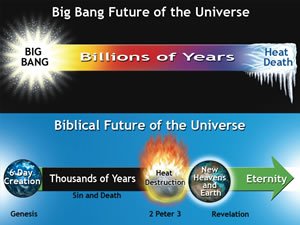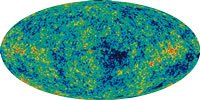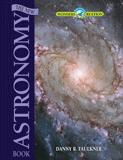
Chapter 3
The Age of the Universe, Part 1
The Bible implicitly teaches us about the age of the universe. Why is it that so many scientists choose to ignore the recorded history of the Bible, and instead believe in a vastly inflated age of the universe?
The age of the universe is a point of dispute between the Bible and the opinion of the majority of astronomers today. The Bible implicitly teaches us about the age of the universe. In other words, it gives us sufficient information so that we can compute approximately how long ago God created the universe. The Bible teaches that the entire universe was created in six earth-rotation days (Exodus 20:11 ). Furthermore, the Bible provides the age differences between parents and descendants1 when listing certain genealogies. From these kinds of biblical references, we know that the elapsed time between Adam and the birth of Christ was roughly 4,000 years. From other historical records, we know that Christ was born roughly 2,000 years ago. Since Adam was created on the sixth day of the creation week, we can conclude that the earth, the entire universe, and everything in it were created approximately 6,000 years ago.
Many people today would scoff at this claim. After all, most geology textbooks, astronomy textbooks, and the majority of schools and universities teach that the earth is 4.5 billion years old, and that the universe is even older, but what is the basis for the secular belief in billions of years? Why is it that so many scientists choose to ignore the recorded history of the Bible, and instead believe in a vastly inflated age of the universe?
Circular reasoning
One answer is circular reasoning: many scientists believe the world is old because they believe most other scientists think the world is old. Although a given scientist may be well aware of evidence that is not consistent with long ages, it is very tempting to dismiss such evidence because, “How could all those other scientists really be wrong?” How many of those other scientists believe in long ages simply because they also think that other scientists do? A majority opinion can become self-sustaining through circular reasoning; people believe because other people believe. It is surprising that many people do not realize the inconsistency here.
Many times, the circular reasoning can be cross-disciplinary. A geologist may feel assured that the earth is billions of years old since most astronomers believe that the solar system is billions of years old. However, an astronomer may feel confident that the solar system is billions of years old since the majority of geologists accept this for the age of the earth. Of course, the majority opinion can be wrong. In fact, many scientific discoveries have gone against the majority. Nonetheless, the psychological pressure to agree with the majority is a very powerful and well-documented phenomenon.2
The evolution connection
It is noteworthy that most (though not all) of the scientists who believe in billions of years also believe in particles-to-people evolution. Evolution requires vast ages. It couldn’t possibly have happened on a mere 6,000-year time scale, because such profound changes would then have to be happening so rapidly that we would not only see massive transformations all around us, we would have historical records of many examples. Yet, we have never seen life evolve from non-life, nor have we ever seen a living organism evolve into another kind with greater specified complexity. These “uphill” changes just aren’t observed; indeed, they seem to be impossible.
The imaginary vast ages are invoked to make these seemingly miraculous leaps feasible. As George Wald has stated, “Time is in fact the hero of the plot. . . . Given so much time, the ‘impossible’ becomes possible, the possible probable, and the probable virtually certain. One has only to wait; time itself performs the miracles.”3 The insurmountable obstacles to evolution are simply swept under the rug of vast ages.
The addition of the billions of years does not actually solve the problems with molecules-to-man evolution. These problems have been addressed in detail on our website at answersingenesis.org and in the materials available there, and so there is no need to elaborate in this astronomy book. The point here is simply that evolution requires vast ages. Hence, this is an example of how worldviews can affect a person’s interpretation of evidence. Evolutionists must believe in vast ages. Their worldview bias does not allow them to consider the possibility that the universe could be only thousands of years old, regardless of what recorded history teaches, and regardless of any scientific evidence. People who reject molecules-to-man evolution would do well to remember this before jumping on board with the vast ages.
The big-bang connection

Conceptual artwork of several areas of inflation (domes) in the early Universe
I have found that most people who believe in billions of years also believe in the “big-bang theory.” The big bang is a secular speculation about the origin of the universe; it is an alternative to the Bible. The big bang attempts to explain the origin of the universe without God. It can be considered the cosmic equivalent of particles-to-people evolution. Sadly, a lot of Christians have bought into the idea of the big bang, without realizing that it is based on the anti-biblical philosophy of naturalism (there is no God, nature is all there is or ever was). Furthermore, they are generally not aware that the big bang contradicts the Bible on a number of points and has many scientific problems as well.
According to the big bang idea, the universe is nearly 14 billion years old; whereas the Bible indicates that the universe is about 6,000 years old. For those who claim to believe the Bible, this difference alone should be sufficient reason to reject the big bang. It is wrong about the age of the universe by a factor of over two million! But it is not just a problem of time scale; the Bible gives a different order of events than the current secular opinion. The big bang / naturalistic view teaches that stars formed before the earth, fish came about before fruit trees, and the sun came about long before plants. However, the Bible teaches the exact reverse—that the earth came before stars, fruit trees came before fish, and the plants were created before the sun.

Future of the Universe
The big bang is a story about the alleged past, but it is also a story about the alleged future. According to the currently favored version of the big bang, the universe will continue to expand indefinitely and grow colder. Usable energy will become increasingly scarce, and will eventually cease altogether, at which point the universe will die a “heat death.” At this point, no “heat” will be left, so the universe will have a temperature close to absolute zero everywhere. No life will be possible at that point since no usable energy will exist.
Heat death is a rather bleak scenario, and quite different from the future the Bible teaches. Scripture indicates that the Lord will return in the future in judgment. The paradise lost in Genesis will become a paradise restored. There will be no “heat death,” nor any death of humans or animals, since the Curse will be no more. The new earth will remain perfect in the Lord’s presence forever. (See diagram this page.) Many Christians are inconsistent; they accept what the big bang says about the past (instead of the Bible), but reject what it says about the future (in favor of the Bible).
The Assumptions of Naturalism and Uniformitarianism
A belief in naturalism and uniformitarianism can cause a person to make a vastly inflated estimate of the age of the earth and universe. Recall that naturalism is the belief that nothing exists outside of nature. In this view, the universe and everything in it came about by the same kinds of processes observed within the universe. Naturalism is, of course, an unbiblical concept since the Bible makes it clear that God created the universe supernaturally. The problems with naturalism will be discussed in greater detail in the next chapter. Naturalism often leads to exaggerated age estimates when applied to supernaturally created things.
As an example of this, consider the first man. Adam was created as an adult—a fully grown man. Suppose that we were asked to guess the age of Adam on the seventh day, only 24 hours after God created him. If we incorrectly assumed that Adam was not supernaturally created but that instead he came about the same way people come about today, then we would derive an age that is far too old. A naturalist might guess that the one-day-old Adam was about 30 years old by incorrectly assuming that he grew to adulthood by the same process that other people do today. Naturalism leads to an age estimate for Adam that is 10,000 times too old, but the universe was also supernaturally created. A person who denies this would likely conclude an age that is many times older than the true age.
A belief in uniformitarianism can also lead to severe overestimates of age. Uniformitarianism is the idea that most things in the world today (mountains and canyons, for example) were formed at about the same (i.e., uniform) rates that we see operating in the world today. People who hold to uniformitarianism would assume that radioactive decay has always occurred at the same rate, that canyons have (generally) been eroded at the same rate as today, and that mountains have been uplifted at the same average rate as today. They would certainly deny a worldwide flood (Gen. 6:8) since it would alter these rates dramatically. Uniformitarianism can be summed up by the phrase “the present is the key to the past.”4
However, both naturalism and uniformitarianism are merely philosophical assumptions. They are both anti-biblical since the Bible teaches both a supernatural creation and a worldwide flood. Moreover, naturalism and uniformitarianism can lead to contradictory conclusions (as we will show) which brings into question the reliability of those assumptions.
The distant starlight problem
One of the most common objections to a “young universe” is often called the “distant starlight problem.” There are galaxies in the universe that are incredibly far away. These distances are so extreme that even light would take billions of years to travel from these galaxies to the earth. Yet, we do see these galaxies; this indicates that the light has traveled from there to here. Since this process is supposed to take billions of years, the universe must be at least billions of years old—much older than the biblical time scale. It is argued that distant starlight therefore supports the big-bang story of origins.
There are actually several different natural mechanisms that God might have used to get the starlight here in thousands of years. These have been published in TJ [now Journal of Creation] and other places and so we will not repeat them here [for more information, see “Does Distant Starlight Prove the Universe Is Old?”]. The point here is to show that the objection itself is vacuous. The argument that distant starlight disproves the biblical account of creation and supports an old “big-bang” universe is based on faulty reasoning.
First, notice that the distant starlight argument is based on the fallacious assumptions of naturalism and uniformitarianism. It assumes that the light got here entirely by natural means, and traveled at a constant rate, over a constant distance, with time also being constant. Of course, it is possible that God may indeed have used “natural means” to get the light here. It may also be that some of the things assumed to be constant in time (such as the speed of light) are indeed constant, but is there any logical reason why we would automatically know beforehand that these must be the case? Remember that God created the lights in the sky to give light upon the earth. This happened during the creation week where God was creating in a supernatural way.
The evolutionist insists that if we cannot show a naturalistic mechanism for a particular event of the creation week (like distant starlight), then the Bible cannot be trusted. This is an unrealistic “heads I win, tails you lose” sort of argument. Since many of the events that happened during the creation week were supernatural in essence, it is irrational to demand a naturalistic explanation for them. It is ridiculous to argue that a supernatural explanation is wrong because it cannot be explained by natural causes. This would be circular reasoning. Now, it is perfectly fine to ask the question, “Did God use natural means to get the starlight from galaxies to earth? And if so, what is the mechanism?” However, if no natural mechanism is apparent, this cannot be a legitimate criticism against supernatural creation anymore than a lack of a natural mechanism for Christ’s resurrection could invalidate that event.
Light travel-time: a problem for the big bang
There is another fatal flaw in using a light travel-time argument like distant starlight to reject the Bible in favor of the big bang. Such an argument is subtly self-refuting. This is because the big bang also has a light travel-time problem! In the big-bang model, light is required to travel a distance much greater than should be possible within the big bang’s own time frame of about 14 billion years. This serious difficulty for the big bang is called the “horizon problem.”
Attempts at compromise
The belief in billions of years has a stranglehold on our culture today—even within the church. Many professing Christians have been taken in by the fallacious distant starlight argument or other eisegetical6 claims involving anti-biblical assumptions. As a result, many Christians have compromised; they have attempted to “add” the billions of years to the Bible. One of the most common methods of trying to believe both the Bible and the billions of years is called the “day age” position. In this view, the days of creation were not actually days, but rather were vast ages—many millions of years each. According to the day-age idea, God created over six long periods of time.
It is important to point out that even if the day-age position were true, it would not bring the biblical account into alignment with the secular story of origins since the order of events is different between the two. Recall that the big bang / naturalism view teaches that stars existed long before fruit trees which came after fish. The Bible teaches that fish were made on day 5 after the stars which were made on day 4, and after the trees which were made on day 3—regardless of how long the days were.
Day-age followers point out that the Hebrew word for day (yom) does not always indicate a “day” in the ordinary sense, but can sometimes mean an unspecified period of time. In certain contexts, “day” can refer to a longer period of time, but not in the context of the days of creation. Similarly, our English word “day” can mean an unspecified period of time in certain contexts like “back in grandfather’s day. . . .” However, it would not mean an unspecified period of time in other contexts such as “five days ago, the third day, day then night, morning of the day, evening of the day, the evening and morning.” Clearly, in the preceding phrases the word “day” must mean an ordinary day from context—not a period of time.
The Hebrew language also obeys grammatical rules, and as with English, the meaning of a word is always determined by its context. The Hebrew word for day means an ordinary day (and is never translated as “time”) when in any of the following contexts:
- When combined with an ordinal (list) number (“the first day, the third day, etc.”) day means an ordinary day—not a period of time.
- When associated with the word “morning,” such as “There was morning that day,” day means an ordinary day—not a period of time.
- When associated with the word “evening,” such as “There was evening that day,” day means an ordinary day—not a period of time.
- When evening and morning occur together, such as “There was evening and morning” (even if the word “day” is not present), this constitutes an ordinary day—not a nonspecific period of time.
- When contrasted with “night,” such as “There was night then day,” the word day means an ordinary day—not a period of time.


In Genesis chapter 1, we see all of these contextual indicators used for the days of creation. The days of creation must be ordinary days from context; they cannot be long periods of time because context does not permit this. It would be wrong to try and read “day” to mean “a period of time” in Genesis 1, when the context clearly precludes such a meaning; such an error is called an unwarranted expansion of an expanded semantic field. The day-age idea is not logically sound; it is simply an unsuccessful attempt to make the Bible compatible with anti-biblical notions.7
Ultimately, the Bible teaches that God created in six days and the secular opinion is that the universe evolved over billions of years. Each of us must decide whether we are going to trust the secular opinions of human beings, or the clear teaching of the Bible. As we saw in the last chapter, the Bible has always been correct when it touches upon astronomy.
It is important to remember that we are at just another point in history. Yes, people today will scoff at and ridicule a belief in a “young universe.” Then again, many of those same people will ridicule a belief in Jesus being the one true God, or even the very belief in a Creator. The Bible has always been vindicated in the past. So there is no reason to cave in to mere peer pressure today.
The evidence confirms a young universe
Even now, the scientific evidence is very consistent with what the Bible teaches about the age of the universe. Why then do many secular scientists believe that the evidence points to a multi-billion-year-old universe? People who believe in the big bang generally interpret the evidence according to the big bang (sometimes without even realizing it). In other words, they simply assume that the big bang is true and they interpret the evidence to match their beliefs. We all interpret the evidence in light of our worldview; there is no getting around it. However, the Bible can also be used to interpret the evidence. Since the Bible records the true history of the universe, we will see that it makes a lot more sense of the evidence than the big bang does. Let us now look at some facts about the universe. We will see that the evidence is consistent with 6,000 years, but doesn’t make as much sense if we hold to the big bang.
Of course, big-bang supporters can always reinterpret the evidence by adding on extra assumptions, so, these facts that follow are not intended to “prove” that the Bible is right about the age of the universe. The Bible is right in all matters because it is the Word of God. However, when we understand the scientific evidence, we will find that it agrees with what the Bible teaches. The evidence is certainly consistent with a “young” (roughly 6,000-year-old) universe.
Creation In-Depth:
The Horizon Problem
In the big-bang model, the universe begins in an infinitely small state called a singularity, which then rapidly expands. According to the big-bang model, when the universe was still very small it would have developed different temperatures in different locations. Let’s suppose that point A is hot and point B is cold. Today, the universe has expanded and points A and B are now widely separated.

However, the universe has an extremely uniform temperature at great distance—beyond the farthest known galaxies. In other words, points A and B have almost exactly the same temperature today. We know this because we see electromagnetic radiation coming from all directions in space in the form of microwaves. This is called the “cosmic microwave background” (CMB). The frequencies of radiation have a characteristic temperature of 2.7 K and are extremely uniform in all directions. The temperature deviates by only one part in 105.
The problem is this: how did points A and B come to be the same temperature? They can only do this by exchanging energy. There are many systems where this happens; consider an ice cube placed in hot coffee. The ice heats up and the coffee cools down by exchanging energy. Likewise, point A can give energy to point B in the form of electromagnetic radiation (light). (This is the fastest way of transferring energy since nothing can travel faster than light.) However, using the big bang supporters’ own assumptions (such as uniformitarianism and naturalism), there has not been enough time in 14 billion years to get light from A to B; they are too far apart. This is a light travel-time problem—and a very serious one. After all, A and B have almost the same temperature today, and so must have exchanged light multiple times.
Big-bang supporters have proposed a number of conjectures which attempt to solve the big bang’s light travel-time problem. One of the most popular is called “inflation.” In “inflationary” models, the universe has two expansion rates; a normal rate and a fast “inflation” rate. The universe begins with the “normal” rate (which is actually quite rapid, but is slow by comparison to the next phase). Then it enters the inflation phase, where the universe expands much more rapidly. At a later time, the universe goes back to the normal rate. This all happens early on, long before stars and galaxies form.
The inflation model allows points A and B to exchange energy (during the first normal expansion) and to then be pushed apart during the inflation phase to the enormous distances at which they are located today, but the inflation model amounts to nothing more than storytelling, with no supporting evidence at all. It is merely a speculation designed to align the big bang to conflicting observations. Moreover, inflation adds an additional set of problems and difficulties to the big-bang model, such as what would cause such inflation, and how to turn it off in a graceful fashion. An increasing number of secular astrophysicists are rejecting inflation for these reasons and others. Clearly, the horizon problem remains a serious light travel-time problem for the big bang.
The critic may suggest that the big bang is a better explanation of origins than the Bible since biblical creation has a light travel-time problem—distant starlight. Such an argument is not rational since the big bang has a light travel-time problem of its own. If both models have the same problem in essence,5 then that problem cannot be used to support one model over the other. Therefore, distant starlight cannot be used to dismiss the Bible in favor of the big bang.
Taking Back Astronomy
Dr. Lisle communicates the truths of creation and the fallacies of evolution with authority and enthusiasm. In this richly illustrated book, Lisle debunks the most widely accepted teachings about the idea of evolution. Readers are given solid answers to many questions, including the speed of light, the big bang, extraterrestrials, the reliability of the Bible regarding astronomy, and more.
Read Online Buy BookFootnotes
- I.e., it gives the age of the ancestor at the time the descendant was born, thus making the genealogy “watertight.”
- [Carl Wieland, “Herd Rule,” Creation, March 2002.]
- George Wald (late professor of biology, Harvard University), “The Origin of Life,” Scientific American (August, 1954): p. 48.
- Many secular scientists are increasingly acknowledging the importance of catastrophic events in earth’s history.
- The details, of course, differ. The big bang does not have a problem with distant starlight as such. Then again, biblical creation does not have a horizon problem. (The CMB does not need to start with different temperatures in a creationist cosmogony.) However, both problems are the same in essence: how to get light to travel a greater distance than seems possible in the time allowed.
- Eisegesis means reading things into the biblical text, as opposed to exegesis, understanding what the text is actually teaching.
- The day-age position has been thoroughly refuted in the book Refuting Compromise by Dr. Jonathan Sarfati (Green Forest, AR: Master Books, 2004).
Recommended Resources

Answers in Genesis is an apologetics ministry, dedicated to helping Christians defend their faith and proclaim the good news of Jesus Christ.
- Customer Service 800.778.3390
- Available Monday–Friday | 9 AM–5 PM ET
- © 2026 Answers in Genesis


